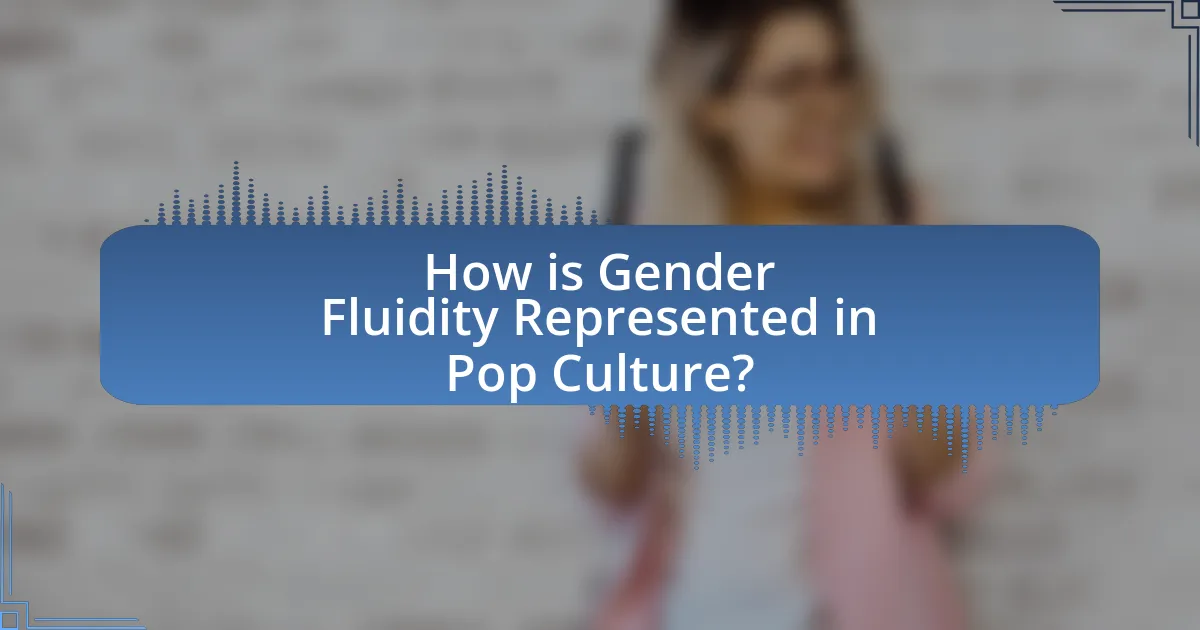Gender fluidity in fashion represents a significant shift away from traditional gender norms, allowing individuals to express their identities beyond binary classifications. This article explores how gender fluidity challenges conventional fashion standards, highlighting the rise of unisex collections and the influence of cultural movements and celebrities in promoting inclusivity. It examines the historical context that has shaped this trend, the impact of societal perceptions on fashion choices, and the importance of gender fluidity in fostering self-expression. Additionally, the article addresses the challenges faced by gender-fluid individuals in the fashion industry and offers insights into how brands and consumers can advocate for more inclusive practices.

What is Gender Fluidity in Fashion?
Gender fluidity in fashion refers to the concept where clothing and style are not confined to traditional gender norms, allowing individuals to express themselves beyond the binary classifications of male and female. This movement has gained traction in recent years, with designers and brands increasingly creating collections that cater to a diverse range of gender identities. For instance, high-profile figures like Billy Porter and Jaden Smith have popularized gender-fluid fashion, showcasing garments that challenge conventional gendered aesthetics. The rise of gender-neutral clothing lines, such as those from brands like Telfar and Rad Hourani, further illustrates this shift, reflecting a broader cultural acceptance of fluid gender identities in contemporary society.
How does gender fluidity challenge traditional fashion norms?
Gender fluidity challenges traditional fashion norms by blurring the lines between male and female clothing, allowing individuals to express their identity beyond binary classifications. This shift is evident in the rise of unisex collections and the increasing acceptance of styles traditionally associated with the opposite gender, such as skirts for men and tailored suits for women. The impact of gender fluidity is supported by the growing popularity of brands like Gucci and Telfar, which promote inclusive designs that cater to diverse gender expressions. Additionally, cultural movements and social media platforms have amplified visibility for gender fluid individuals, further encouraging the fashion industry to adapt and embrace a more inclusive approach.
What historical context has shaped gender fluidity in fashion?
Historical context shaping gender fluidity in fashion includes the androgynous styles of the 1920s, the gender-bending movements of the 1970s, and the influence of LGBTQ+ culture. In the 1920s, women began to adopt masculine clothing, such as suits and bobbed hair, challenging traditional gender norms. The 1970s saw the rise of glam rock and punk fashion, where artists like David Bowie and Freddie Mercury blurred gender lines through their clothing choices. Additionally, the LGBTQ+ rights movement has played a crucial role in promoting acceptance of diverse gender expressions, further influencing fashion trends. These historical shifts demonstrate how societal changes and cultural movements have contributed to the evolution of gender fluidity in fashion.
How do cultural perceptions of gender influence fashion choices?
Cultural perceptions of gender significantly influence fashion choices by dictating what is considered acceptable or desirable attire for different genders. For instance, in many Western societies, traditional gender norms have historically associated femininity with dresses and skirts, while masculinity has been linked to suits and trousers. This binary view shapes consumer behavior, as individuals often select clothing that aligns with societal expectations to avoid stigma or discrimination.
Research indicates that as cultural perceptions evolve towards greater acceptance of gender fluidity, fashion choices also diversify, allowing individuals to express their identities beyond traditional gender norms. A study published in the Journal of Fashion Marketing and Management highlights that brands embracing gender-neutral clothing lines have seen increased sales, reflecting a shift in consumer demand towards inclusivity and self-expression. This demonstrates that cultural perceptions not only shape individual choices but also influence market trends and brand strategies in the fashion industry.
Why is gender fluidity important in contemporary fashion?
Gender fluidity is important in contemporary fashion because it challenges traditional gender norms and promotes inclusivity. This shift allows designers and brands to create clothing that transcends binary classifications, appealing to a broader audience. For instance, major fashion houses like Gucci and Balenciaga have embraced gender-neutral collections, reflecting a growing consumer demand for diversity in style. According to a 2021 report by McKinsey & Company, 60% of Gen Z consumers prefer brands that represent a variety of gender identities, highlighting the market’s shift towards acceptance and representation. This evolution in fashion not only fosters self-expression but also encourages societal change by normalizing fluidity in gender identity.
What impact does gender fluidity have on self-expression in fashion?
Gender fluidity significantly enhances self-expression in fashion by allowing individuals to transcend traditional gender norms and embrace a more personalized style. This shift encourages creativity and diversity in clothing choices, as people feel empowered to mix and match elements typically associated with masculinity and femininity. For instance, the rise of gender-neutral fashion lines, such as those from brands like Telfar and Rad Hourani, illustrates how the industry is adapting to these changes, promoting inclusivity and broader representation. Studies show that individuals who identify as gender fluid often report higher levels of self-esteem and authenticity when expressing their identity through fashion, reinforcing the positive impact of this movement on personal expression.
How does gender fluidity promote inclusivity in the fashion industry?
Gender fluidity promotes inclusivity in the fashion industry by challenging traditional gender norms and allowing individuals to express their identities freely. This shift encourages designers and brands to create collections that cater to a diverse range of gender expressions, moving beyond binary classifications. For instance, brands like Gucci and Telfar have embraced gender-neutral clothing lines, reflecting a growing market demand for inclusivity. According to a 2021 report by McKinsey & Company, 67% of consumers believe that brands should be more inclusive in their marketing and product offerings, highlighting the importance of gender fluidity in appealing to a broader audience.

How is Gender Fluidity Represented in Pop Culture?
Gender fluidity is represented in pop culture through diverse expressions in fashion, music, and media that challenge traditional gender norms. Prominent figures such as Billy Porter and Jaden Smith exemplify this representation by embracing clothing that defies gender binaries, showcasing skirts and makeup in mainstream settings. Additionally, television shows like “Pose” and “Euphoria” highlight gender fluid characters, further normalizing fluid identities. The increasing visibility of non-binary and genderqueer individuals in advertising campaigns, such as those by brands like Gucci and ASOS, reinforces the acceptance of gender fluidity in contemporary culture. This shift reflects a broader societal movement towards inclusivity and the dismantling of rigid gender roles.
What role do celebrities play in promoting gender fluidity in fashion?
Celebrities play a crucial role in promoting gender fluidity in fashion by challenging traditional gender norms and showcasing diverse styles. High-profile figures like Billy Porter and Harry Styles have publicly embraced gender-neutral clothing, influencing their fans and the fashion industry to adopt more inclusive practices. For instance, Harry Styles made headlines by wearing a dress on the cover of Vogue in December 2020, which sparked widespread discussions about masculinity and fashion. This visibility encourages acceptance and normalizes gender fluidity, leading to a broader cultural shift towards inclusivity in fashion.
Which notable figures have embraced gender fluidity in their style?
Notable figures who have embraced gender fluidity in their style include Billy Porter, Jaden Smith, and Harry Styles. Billy Porter is known for his extravagant red carpet looks that often blend traditional gender norms, such as wearing a tuxedo gown at the 2019 Oscars. Jaden Smith has challenged gender norms through his fashion choices, including wearing skirts and dresses, which he has discussed in interviews as a form of self-expression. Harry Styles has also made headlines for his gender-fluid fashion, notably wearing a dress on the cover of Vogue in December 2020, which sparked conversations about masculinity and fashion. These individuals exemplify the growing acceptance and visibility of gender fluidity in contemporary fashion.
How do media portrayals of gender fluidity influence public perception?
Media portrayals of gender fluidity significantly influence public perception by normalizing diverse gender expressions and challenging traditional gender norms. When media representations include gender-fluid individuals in various contexts, such as fashion, television, and advertising, they help to create visibility and acceptance, which can lead to greater societal understanding. For instance, studies have shown that increased representation of gender diversity in media correlates with more positive attitudes towards LGBTQ+ communities. A report by GLAAD in 2021 indicated that 20% of LGBTQ+ individuals felt more accepted due to media portrayals, highlighting the impact of visibility on public perception. Thus, media plays a crucial role in shaping attitudes towards gender fluidity by fostering inclusivity and reducing stigma.
How do fashion brands respond to the trend of gender fluidity?
Fashion brands respond to the trend of gender fluidity by creating unisex collections and promoting inclusive marketing strategies. Many brands, such as Gucci and Balenciaga, have introduced gender-neutral clothing lines that challenge traditional gender norms, allowing consumers to express their identities freely. This shift is supported by market research indicating that 62% of Gen Z consumers prefer brands that embrace gender inclusivity, highlighting a significant demand for such products. Additionally, fashion shows increasingly feature models of diverse gender identities, further normalizing gender fluidity in the industry.
What are some examples of brands that have adopted gender-neutral collections?
Brands that have adopted gender-neutral collections include Gucci, which launched its unisex line in 2017, and Telfar, known for its inclusive approach to fashion. Other notable examples are ASOS, which offers a dedicated gender-neutral section, and Zara, which introduced a unisex collection in 2020. These brands reflect a growing trend towards inclusivity in fashion, catering to diverse gender identities and preferences.
How do marketing strategies change to accommodate gender fluidity?
Marketing strategies adapt to accommodate gender fluidity by embracing inclusive messaging and diverse representation. Brands increasingly utilize gender-neutral language and imagery in their campaigns to resonate with a broader audience, reflecting the fluid nature of gender identity. For instance, companies like ASOS and Zara have launched unisex clothing lines, showcasing their commitment to inclusivity. Research indicates that 62% of consumers prefer brands that support gender diversity, highlighting the market demand for such strategies. By aligning their marketing efforts with the values of gender fluidity, brands not only enhance customer loyalty but also tap into a growing demographic that seeks representation and authenticity in fashion.

What are the Challenges and Critiques of Gender Fluidity in Fashion?
The challenges and critiques of gender fluidity in fashion include societal resistance, commercial viability, and the risk of commodification. Societal resistance manifests in traditional gender norms that often marginalize non-binary expressions, leading to backlash against gender-fluid individuals and their fashion choices. Commercial viability is a concern as brands may hesitate to invest in gender-fluid lines due to perceived limited market demand, despite a growing consumer base advocating for inclusivity. Additionally, the risk of commodification arises when gender fluidity is co-opted by mainstream fashion, potentially diluting its original meaning and significance, as seen in instances where brands market gender-neutral clothing without genuine commitment to inclusivity. These critiques highlight the complexities of integrating gender fluidity into the fashion industry while maintaining authenticity and addressing broader societal attitudes.
What obstacles do gender-fluid individuals face in the fashion industry?
Gender-fluid individuals face significant obstacles in the fashion industry, primarily due to a lack of representation and inclusivity. Many mainstream fashion brands often adhere to binary gender norms, which limits the availability of clothing that caters to non-binary identities. According to a 2021 report by the Human Rights Campaign, 70% of LGBTQ+ individuals reported experiencing discrimination in retail settings, highlighting the pervasive bias against gender-fluid individuals. Additionally, the fashion industry’s marketing strategies frequently reinforce traditional gender roles, making it challenging for gender-fluid individuals to find styles that resonate with their identity. This lack of tailored options and acceptance can lead to feelings of alienation and exclusion within the fashion community.
How do societal norms and expectations hinder gender fluidity in fashion?
Societal norms and expectations hinder gender fluidity in fashion by enforcing rigid gender binaries that dictate acceptable clothing choices for individuals based on their perceived gender. These norms often manifest through cultural stereotypes, media representation, and institutional practices that promote traditional masculinity and femininity, discouraging individuals from expressing themselves outside these confines. For instance, studies show that individuals who deviate from gender norms in their fashion choices often face social stigma, discrimination, or exclusion, which reinforces conformity to established gender roles. This pressure to adhere to societal expectations limits the acceptance and visibility of gender fluidity in fashion, ultimately stifling personal expression and diversity in style.
What are the criticisms of the commercialization of gender fluidity?
The commercialization of gender fluidity faces criticisms primarily for commodifying identity and reducing it to a marketing strategy. Critics argue that this commercialization often prioritizes profit over genuine representation, leading to superficial portrayals that do not reflect the complexities of gender fluidity. For instance, brands may exploit gender fluidity trends without supporting the underlying social movements or communities, resulting in a dilution of the message and experience of those who identify as gender fluid. Additionally, there is concern that such commercialization can reinforce stereotypes and create a cycle where authentic expressions of gender identity are overshadowed by consumerism, ultimately undermining the very essence of gender fluidity as a form of personal and social expression.
How can the fashion industry improve its approach to gender fluidity?
The fashion industry can improve its approach to gender fluidity by embracing inclusive design practices that cater to diverse gender expressions. This can be achieved by creating unisex collections that prioritize comfort and versatility, allowing individuals to choose clothing that aligns with their identity rather than conforming to traditional gender norms. For instance, brands like Telfar and Rad Hourani have successfully launched gender-neutral lines that challenge conventional sizing and styles, demonstrating market demand for such offerings. Additionally, incorporating diverse models in marketing campaigns can further normalize gender fluidity, as seen in campaigns by companies like ASOS and Zara, which feature a range of gender identities. This shift not only reflects societal changes but also taps into a growing consumer base that values authenticity and representation in fashion.
What best practices can brands adopt to support gender fluidity?
Brands can adopt inclusive marketing strategies, diverse product offerings, and gender-neutral language to support gender fluidity. Inclusive marketing strategies involve representing gender fluid individuals in advertising campaigns, which can enhance brand relatability and foster a sense of belonging. Diverse product offerings should include clothing and accessories that cater to various gender expressions, ensuring that all customers feel represented and valued. Additionally, using gender-neutral language in communications and product descriptions can create a more welcoming environment for individuals who identify outside the traditional gender binary. These practices not only align with contemporary societal values but also reflect a growing consumer demand for inclusivity, as evidenced by studies showing that 70% of consumers prefer brands that support diversity and inclusion initiatives.
How can consumers advocate for more inclusive fashion choices?
Consumers can advocate for more inclusive fashion choices by actively supporting brands that prioritize diversity and representation in their designs. By purchasing from companies that offer gender-neutral clothing and cater to various body types, consumers signal to the fashion industry the demand for inclusivity. Research indicates that 67% of consumers prefer brands that reflect their values, including inclusivity, which encourages brands to adopt more diverse practices. Additionally, consumers can utilize social media platforms to voice their preferences and share their experiences, amplifying the call for inclusive fashion. Engaging in conversations about representation and advocating for policy changes within the fashion industry further strengthens this movement.
What practical tips can individuals follow to embrace gender fluidity in their fashion choices?
Individuals can embrace gender fluidity in their fashion choices by incorporating a mix of traditionally masculine and feminine clothing items into their wardrobe. This can include wearing oversized shirts, tailored blazers, or skirts regardless of gender norms. Additionally, experimenting with accessories such as jewelry, hats, and bags that defy gender conventions can enhance personal expression. Research indicates that fashion is a significant medium for self-identity, and studies show that individuals who adopt gender-fluid styles often report increased confidence and self-acceptance.

